Weekly wild news from our reserves – 10 March 2023
Bristly haircup moss at Wangford Warren, Joe Bell-Tye.
We are 33% of the way to our funding target of £1 million for our exciting new nature reserve, Martlesham Wilds. Charlie and Michael have been guiding groups of local people for walks and chatting about our vision for this lovely corner of Suffolk where nature will take the lead once more.
On Monday 27th February, Charlie and Michael hosted one of their Discovery Walks. It is going to take some time for Martlesham Wilds to settle in to its new, wilder regime, and it’s great to see so many local people so keen to learn more about it.
Pictured is Charlie collecting an enormous cheque for £100 for a talk for the very welcoming Woodbridge Society this week. Lots of kind individual donations were received too, thank you!
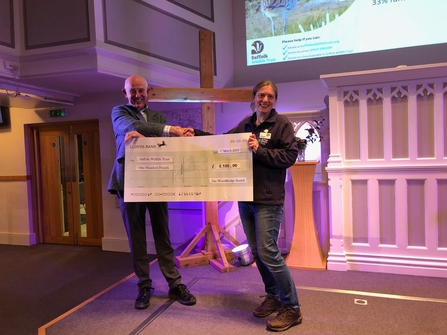
Charlie being presented a cheque from the Woodbridge Society for Martlesham Wilds
Michael found some shells had mysteriously been placed on this fallen oak tree. Human or animal he wondered? Sites Manager Andrew Excell thinks a hungry gull has been gathering the shells from the riverbank and broken them open on the hard surface of the wood. How clever!
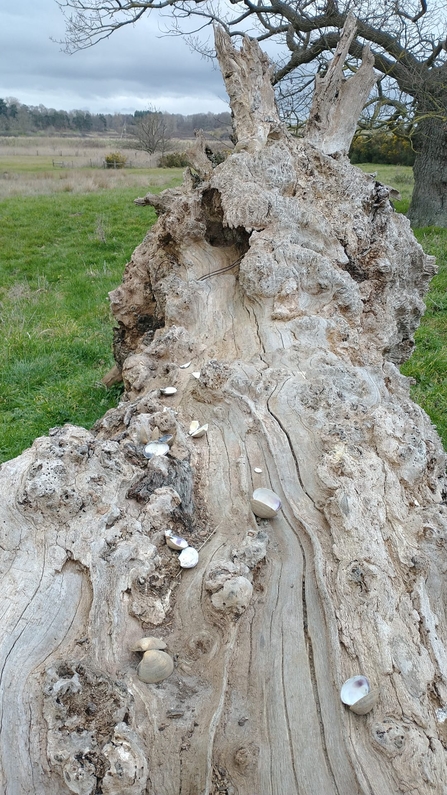
A gull’s recycling bin. Michael Strand.
If you’d like to support Martlesham Wilds, please visit our website to find out how you can help...
Daytime barn owls
We’ve had two photos of barn owls in the daytime sent in this week. Barn owls will sometimes hunt in the daytime and can be seen 'quartering' over farmland and grassland looking for their next small-mammal meal. However, they are perfectly adapted to hunt with deadly precision in the dark of night: combined with their stealthy and silent flight, their heart-shaped faces direct high-frequency sounds, enabling them to find mice and voles in the vegetation.
Flat-backed millipede
Our Reserves intern Anneke Emery spotted this flat-backed millipede at Bradfield Woods. As well as this species, there were lots of common black millipedes and a couple of centipedes amongst the leaf-litter, too. They are important recyclers of nutrients and feed on decaying matter.
You can find out more about flat-backed millipedes here.
Pollard at Bradfield Woods
Alex Lack and the woodlands team have pollarded a boundary oak. Pollarding is a traditional management technique used over hundreds of years. It’s an effective way to reduce the amount of shade cast by the tree and a way of pruning it while still promoting its growth. Pollarded trees can live a very long time and have been used as boundary markers historically.
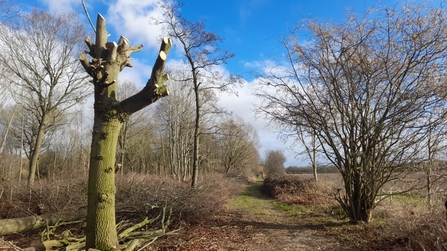
Boundary oak pollard at Bradfield Woods, Alex Lack
Tiny wonders
Warden Joe Bell-Tye has a well-trained eye for spotting tiny, botanical wonders. At Wangford Warren this week, he found some bristly haircap moss, Polytrichum piliferum. This lovely little moss loves the acidic Breckland sandy soils of Wangford Warren.
Joe also spotted the startling bright, but very small, scarlet elfcup fungus, Sarcoscypha austriaca at Lackford Lakes. It can be seen in late winter and early spring on fallen twigs and branches (often hazel, elm and willow), usually buried under moss. It is reasonably widespread, but not very common. It is mostly found in damp, shady areas.
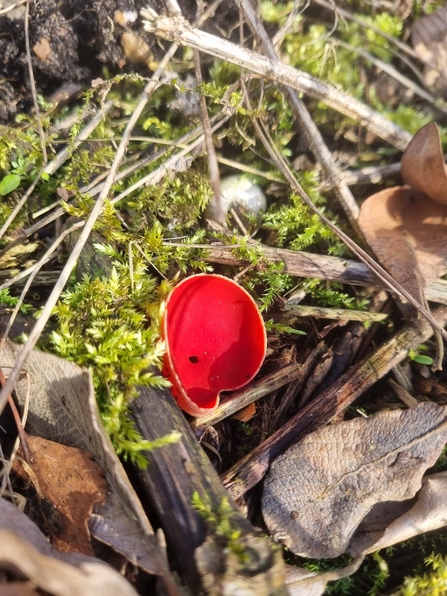
Scarlet elfcup fungus at Lackford Lakes, Joe Bell-Tye
Caught on camera
This week's movie stars include a great white egret filmed by Anneke Emery and a badger on the trail cam at Bradfield Woods. It’s great to see the great white egret alongside a heron as you can appreciate its size relative to the more commonly seen little egret which is much smaller.
Badger at Bradfield Woods (https://youtu.be/S29DWCVfNd0)
Badger at Bradfield Woods
Great white egret and a heron at Lackford Lakes, Anneke Emery (https://youtu.be/YgatM9SILeA)
Great white egret and a heron at Lackford Lakes, Anneke Emery
Hawk Honey, our visitor engagement officer at Lackford Lakes was sent this photo of a great white egret – very possibly the same bird - from a visitor to the reserve (thank you!). What an elegant bird, and a great shot!
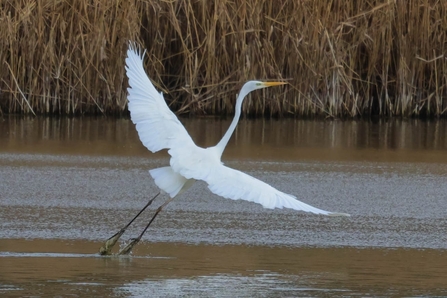
Great white egret at Lackford Lakes taken by a visitor – unfortunately we don’t have a name to credit – thank you to whoever you are – we’d like to credit you if you can contact us!
Framlingham Mere repairs
Warden Joe Underwood and Rowan Tomsett have been repairing the cattle corral that was damaged by a fallen willow tree. It’s now looking much better!
Snape Marshes
Warden Rachel Norman (as seen on BBC Countryfile last weekend) has been overseeing a lot of work at Snape Marshes. We have been ‘tree shearing’ in advance of clearing out the dykes and before the bird breeding season starts. We have hired in an excavator machine with an implement on the front that can cut back the willows overhanging the dykes.
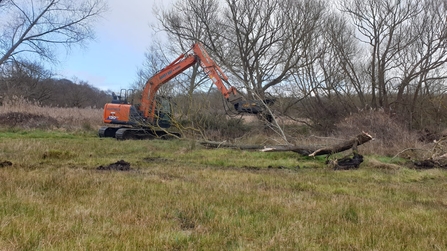
Cutting back the trees overhanging the dykes at Snape Marshes, Rachel Norman
We’re also really pleased to see how muddy Snape Marshes is getting this winter. Thanks to Suffolk Coasts and Heaths Area of Outstanding Natural Beauty funding, the South East reserves team has been able to create lots of foot drains. There is an excavator on site that has been connecting up some of the drains to the scrapes. This will allow us to control the water levels and keep them wet over the summer months. There are plenty of birds moving in already to feed on the disturbed ground – lapwing, redshank, pied wagtail, meadow pipits and black-headed gulls.
Repairs at Castle Marshes
Wardens Lewis Yates, Gavin Durrant and Assistant Warden Frances Lear have been repairing fences and gates at Castle Marshes in preparation for the return of our conservation grazing cattle in the spring. The picture shows another post going in.
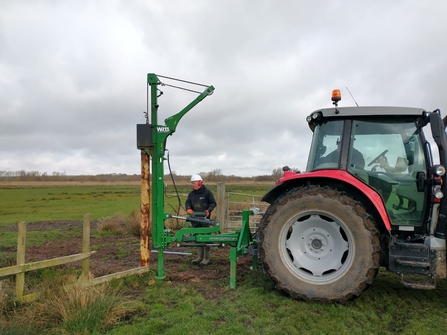
Another post going in at Castle Marshes. Lewis Yates
And finally...
We end with a pair of socially-distanced oystercatchers spotted by Anneke Emery at Lackford Lakes.
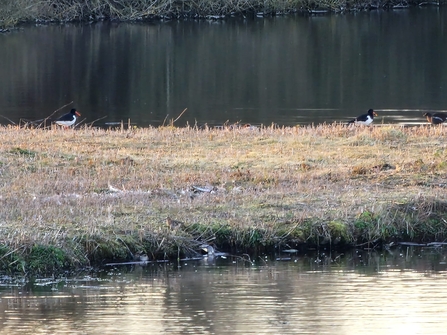
Oystercatchers at Lackford Lakes, Anneke Emery
If you’d like to visit one of our reserves this weekend, you can find a list of places to visit here...
Visit Suffolk Wildlife Trust's nature reserves
We'd love it if you can support us by making a donation, by volunteering with us or becoming a member.
Thank you!

















